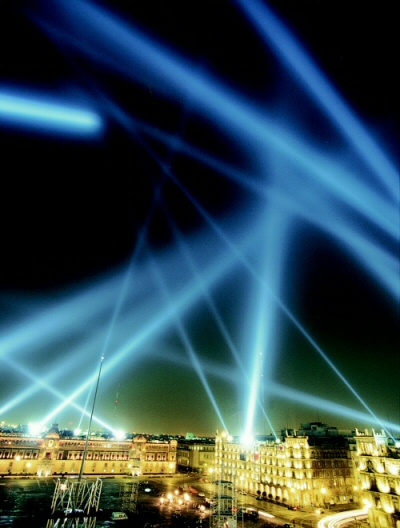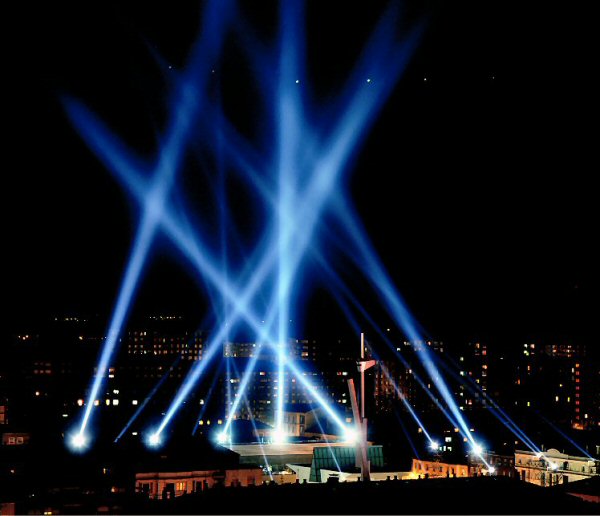Rafael Lozano-Hemmer
(Montreal, Quebec, Canada)
After receiving a B.Sc. (Physical Chemistry with a minor in Art History) from Concordia University in Montreal, Canada, Rafael Lozano-Hemmer began to rapidly explore the electronic arts. Well known for his large-scale, interactive installations in public spaces, he has participated in many important events since 1990, the most recent of which are the Istanbul Biennial (2001) in Turkey, the Havana Biennial (2000) in Cuba, and the Ars Electronica (2002) festival in Linz, Austria. Throughout his career he has received numerous awards and distinctions, including the prestigious Ars Electronica 2000 Golden Nica award for his Vectorial Elevation . His articles have been published in several publications, including Leonardo (US), Kunstforum (Germany), and Archis (Netherlands). He has also given lectures and workshops, in particular, at the Massachusetts Institute of Technology MediaLab, the Guggenheim Museum, the Netherlands Architecture Institute, the Transmediale in Berlin and the Art Institute of Chicago. (2)
Lozano-Hemmer's name and works are now synonymous with the concept of "relational architecture." Developed by the artist, this concept reflects his desire to create social situations, which combine performances and encounters, by using technology to change how people relate to urban architecture. He emphasizes that the use of the adjective "relational" seeks to avoid the already hackneyed "interactive" label. He also stakes no claims on the term since it has been used in the context of relational databases since the 1960s. Furthermore, in the same decade, the Brazilian artists Lygia Clark and Hélio Oiticica applied the term to describe user-activated and manipulated objects and installations.
Vectorial Elevations, the fourth in the Relational Architecture series, is without a doubt Lozano-Hemmer's most well-known telerobotic installation. In March 1998, Rafael Tovar y de Teresa, president of the Mexican National Council for Culture and the Arts, invited him to develop a relational architecture project in the context of Mexico City's millennium celebrations. Among the different guidelines that the project had to respect, there was the choice of a location for the event: the Zócalo square. This square is surrounded by prestigious historical buildings that are symbols of power: the Metropolitan Cathedral, the Supreme Court of Justice building, the National Palace and luxury hotels. There are also Aztec ruins under the square, which is one of the biggest in the world and can accommodate more than 200,000 people.
Vectorial Elevation used two distinct sites: the Zócalo square and a website, which represents a novel and complex encounter between a physical place and a virtual place, each interacting with the other. Around the square, 18 xenon 7000-watt projectors, set up on the rooftops of various buildings, projected light beams that could be seen over a 15-kilometer distance. It was the visitors to the website that created the immense light sculptures displayed in the sky from 6 PM to 6 AM between December 26, 1999 and January 7, 2000. With contributions from 800,000 people on four continents, this was truly a collective public art project.
This project reversed the usual context of most of Lozano-Hemmer's other projects: in this case, the physically present spectators of the sculptures were passive, whereas the web surfers, the real actors in the event, were active. The neologism telecreation fittingly describes this project. The website displayed a 3-D simulation of the Zócalo square and an interface that enabled the participants to create a choreographed lighting design and to visualize it from different perspectives. When the design was sent to the control center in Mexico City, it was numbered and entered into a queue. The projectors changed position every six seconds and the new configuration was filmed by three webcams in order to transmit it live. An archival web page was created for each participant. The page included his/her name, place of residence, commentaries, and the date and time on which his/her design was displayed. As soon as a design was displayed, the participant responsible received an email with the URL of his/her personal page. (3)
This event-based installation corresponds perfectly to what David E. Nye has called the "technological sublime." (4) The author extends the Kantian concept of the sublime and broadens its reach by arguing that it can no longer be applied only to Nature; rather, it must also take into account the complexity of technological developments. Whatever the case may be, the experience remains the same: the sense of humility and modesty of humanity vis-à-vis immensity, grandeur, and the boundless. However, the use of the projectors can also evoke the famous celebrations orchestrated by Albert Speer for the Nazi regime, especially the "Light Dome" created for the 1935 Nuremberg Nazi Party convention. Today, many companies or large corporations use the projectors for advertising purposes, as well as in rock concerts and raves. Fully aware of all these connotations, Lozano-Hemmer managed to bypass and ultimately subvert the usual military and commercial use of light projections by creating a shared work of art. Moreover, this project also follows in the tradition of Sky Art, an art trend launched by Otto Piene in the '60s.
The installation Body Movies, the sixth in the Relational Architecture series, was presented for the first time in the Schouwburgplein square in downtown Rotterdam, from August 31 to September 23, 2001. The immediate visual references that come to mind here are Chinese shadowplays and puppet theater. The device is surprisingly simple, despite the technology behind it: more than a thousand portraits taken on the streets of Rotterdam, Madrid, Mexico, and Montreal are projected from two towers onto the 90 x 22 meter façade of the Pathé cinema. On the ground, two 7000 watt xenon projectors project an intense light on the oversized portraits that are blotted out by the white glare, and disappear. The portraits only reappear inside and through the shadows of passers-by who block the light projected from the ground. When the shadows of the participating passers-by are superimposed on all of the portraits, these disappear completely, creating a sense of suspense until the new series of portraits appears. All of this happens quite quickly. Nothing is fixed here; everything is in the process of becoming. This is truly an anti-monument : for the artist, the term refers to an action, a performance, which clearly rejects the notion of a monument developed from an elitist point of view as an emblem of power. Everybody is aware of the artificiality of the anti-monument. The anti-monument is an alternative to the fetish of location and the fetish of representations of power. (5) Bearing this in mind, you can rapidly understand why Vectorial Elevation is an anti-monument par excellence.
What does this anti-monument offer us? In the video that documents the Rotterdam installation, you can see all kinds of crazy scenes that take place in a carnivalesque atmosphere worthy of Rabelais. But there are also troubling scenes where, for a brief moment, two identities fuse and seem to take on each others’ personalities. Furtive interactions and relationships are established. It’s as though the installation made this identity transfer possible. Some participants are not even interested in the portraits and prefer to stage themselves, discreetly or in a coarse manner. The installation generously leaves it up to the participants to choose their own role and how they wish to get involved. It is interesting to note that the participants preferred to use their projected shadows to stage puppet theater-inspired situations. This was a perfect occasion to let loose and give free rein to the imagination. But as the artist stated during a recent conference (6), the participants' reaction is not always in line with the initial expectations; this is because the cultural context of the city where the installation is presented has a significant impact on how the work is received. Whatever the case may be, Body Movies and Vectorial Elevation allow the artist to brilliantly explore "the creation, perception and occupation of a public space." (7) And no doubt, in his eyes, the occupation of a public space demands active participation that encourages an encounter. It is a truism to say that a work of art needs spectators. However, in Lozano-Hemmer's case, without participating spectators, the work does not exist at all.
Subtitled Public (2005) was shown at the Montreal Museum of Fine Arts from September 20 to December 9, 2007, for the exhibition e-art: New Technologies and Contemporary Art, Ten Years of Accomplishments by the Daniel Langlois Foundation.
Jacques Perron © 2003 rev. 2009 FDL
(1) Lozano-Hemmer, Rafael. "Alien Relationships with Public Space", TransUrbanism , Rotterdam, V2_Publishing/NAI Publishers, 2002. p. 155.
(2) For more information: http://www.lozano-hemmer.com/bio.php
(3) Lozano-Hemmer, Rafael. "Introduction", Vectorial Elevation , Mexico, Conaculta, 2000, p. 35.
(4) Nye, David E. American Technological Sublime , Cambridge, MIT Press, 1994.
(5) Lozano-Hemmer, Rafael. "Alien Relationships with Public Space", TransUrbanism , Rotterdam, V2_Publishing/NAI Publishers, 2002. p. 155.
(6) Conference given on October 13, 2003 at the Society for Arts and Technology (SAT), Montréal, Canada; as part of the Montreal International Festival New Cinema and New Media (FCMM).
(7) Lozano-Hemmer, Rafael. "Alien Relationships with Public Space", TransUrbanism , Rotterdam, V2_Publishing/NAI Publishers, 2002. p. 148.
Related pages:
 Rafael Lozano-Hemmer, Standards and Double Standards
Rafael Lozano-Hemmer, Standards and Double StandardsAbandoning his public, large-scale images and light projections for the intimacy of a gallery, the artist seeks to embody in a novel way the omnipresent scrutiny of the surveillance camera.
 Rafael Lozano-Hemmer, Subtitled Public (2005)
Rafael Lozano-Hemmer, Subtitled Public (2005)Visitors entering Subtitled Public are tracked and pursued by third person singular verbs that are projected on them as they move about the room.
 Subtitled Public: Documentary Collection, Interview with Rafael Lozano-Hemmer
Subtitled Public: Documentary Collection, Interview with Rafael Lozano-HemmerInterview with Rafael Lozano-Hemmer / Produced by the Daniel Langlois Foundation for Art, Science, and Technology; interviewers: Lizzie Muller, Caitlin Jones; camera: Paul Kuranko (1 hr. 2 min.). Interview conducted October 2007 in Montreal.
 e-art: New Technologies and Contemporary Art
e-art: New Technologies and Contemporary ArtTo mark the tenth anniversary of the DLF, the MMFA has presented works by ten artists who have received funding from the DLF over the years.
External link:
http://www.lozano-hemmer.com/







